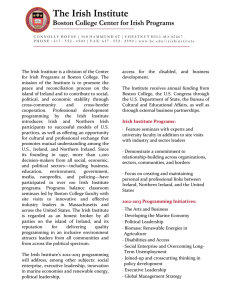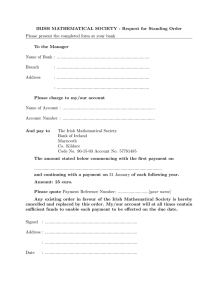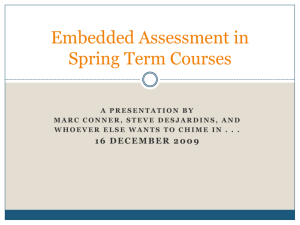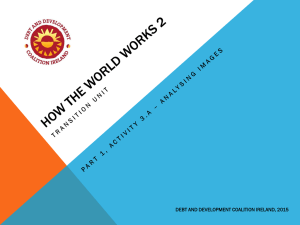irish studies center for irish programs Burns Visiting Scholar, Spring 2016 Semester
advertisement
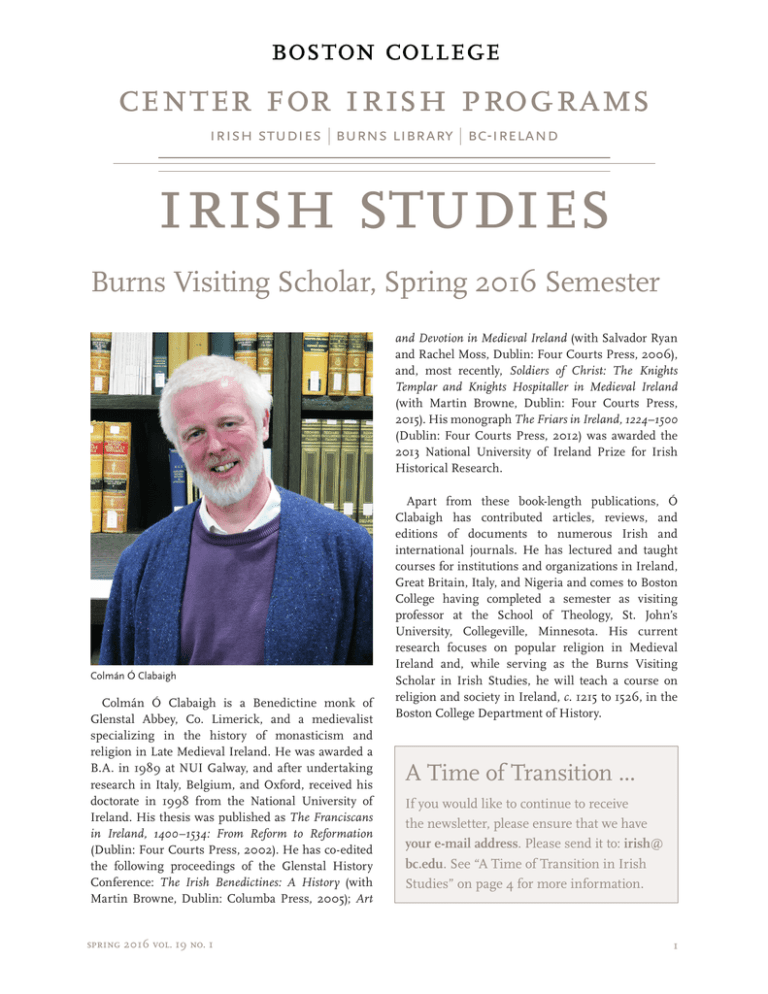
center for irish programs irish studies burns library bc-ireland irish studies Burns Visiting Scholar, Spring 2016 Semester and Devotion in Medieval Ireland (with Salvador Ryan and Rachel Moss, Dublin: Four Courts Press, 2006), and, most recently, Soldiers of Christ: The Knights Templar and Knights Hospitaller in Medieval Ireland (with Martin Browne, Dublin: Four Courts Press, 2015). His monograph The Friars in Ireland, 1224–1500 (Dublin: Four Courts Press, 2012) was awarded the 2013 National University of Ireland Prize for Irish Historical Research. Colmán Ó Clabaigh Colmán Ó Clabaigh is a Benedictine monk of Glenstal Abbey, Co. Limerick, and a medievalist specializing in the history of monasticism and religion in Late Medieval Ireland. He was awarded a B.A. in 1989 at NUI Galway, and after undertaking research in Italy, Belgium, and Oxford, received his doctorate in 1998 from the National University of Ireland. His thesis was published as The Franciscans in Ireland, 1400–1534: From Reform to Reformation (Dublin: Four Courts Press, 2002). He has co-edited the following proceedings of the Glenstal History Conference: The Irish Benedictines: A History (with Martin Browne, Dublin: Columba Press, 2005); Art spring 2016 vol. 19 no. 1 Apart from these book-length publications, Ó Clabaigh has contributed articles, reviews, and editions of documents to numerous Irish and international journals. He has lectured and taught courses for institutions and organizations in Ireland, Great Britain, Italy, and Nigeria and comes to Boston College having completed a semester as visiting professor at the School of Theology, St. John’s University, Collegeville, Minnesota. His current research focuses on popular religion in Medieval Ireland and, while serving as the Burns Visiting Scholar in Irish Studies, he will teach a course on religion and society in Ireland, c. 1215 to 1526, in the Boston College Department of History. A Time of Transition ... If you would like to continue to receive the newsletter, please ensure that we have your e-mail address. Please send it to: irish@ bc.edu. See “A Time of Transition in Irish Studies” on page 4 for more information. 1 Irish Studies Spring 2016 Events The Center for Irish Programs at Boston College is pleased to offer a variety of events that are free and open to the public: January 21 | Thursday, 5:00 p.m. Connolly House Professor Mike Cronin, Academic Director, BCI, presents “The Enemy in Dublin, 1916: Who Were the British?” Sheila Falls Mike Cronin February 4 | Thursday, 6:30-8:30 p.m. Cadigan Alumni Center, Brighton Campus Gaelic Roots Concert of Scottish, Québecois & Celtic music. Featuring cellist Natalie Haas with guitarist/vocalist Yann Falquet. February 8 | Monday, 7:00-9:00 p.m. McMullen Museum of Art, Devlin Hall Public Opening; “The Arts and Crafts Movement: Making It Irish.” Exhibition runs through May 2016. February 9 | Tuesday, 2:00 p.m. McMullen Museum of Art, Devlin Hall “The Arts and Crafts Movement: Making It Irish.” Introduction by Paul Larmour; lecture and gallery walk to follow. February 10 | Wednesday, 5:00-8:00 p.m. Connolly House Waywords and Meansigns Launch of Waywords and Meansigns. Finnegans Wake set to music. Presented by Derek Pyle, David Kahne, Brian Hall, Mike Watt, and many more. February 22 | Monday, 6:00 p.m. Gasson Hall, Room 100 MA Congressman Richard Neal will speak on the Easter Rising of 1916. Richard Neal 2 Jimmy Noonan Kieran Jordan February 25 | Thursday, 6:30-7:30 p.m. Connolly House BC Students & Teachers in Irish Music and Dance, featuring Sheila Falls on fiddle, Jimmy Noonan on tin whistle & dance performance by Kieran Jordan. February 27 | Saturday, 2:00 p.m. Devlin Hall 101 and McMullen Museum of Art Fintan O’Toole presents “Culture & Society in Ireland, 1916; Contexts for the Arts & Crafts Movement.” February 29 | Monday, 4:30-7:00 p.m. Connolly House Hugh O’Neill at 400 Presentations will include: Hiram Morgan (UCC), “Enemy of England: the career of Hugh O’Neill, Earl of Tyrone (1550–1616),” James O’Neill (UCC), “The Nine Years War in Ireland and the Military Revolution”, Ruth Canning (UCC), “The Pale and the political reasons preventing Irish victory in the Nine Years War,” and Malachy O’Neill (Ulster University), “Irish language sources for the Nine Years War and the Flight of the Earls.” March 2 | Wednesday, 4:30 p.m. Burns Scholar Lecture in Burns Library Thompson Room with reception to follow in the Burns Library Irish Room Burns Visiting Scholar Professor Colmán Ó Clabaigh presents “Fifty Ways to Cleave Your Brother: Mayhem, Mischief & Misfits in Medieval Irish Monasteries.” March 9 | Wednesday, 6:00 p.m. April 7 | Thursday, 6:30-8:30 p.m. Boston College-Ireland 43 St. Stephen’s Green, Dublin Catalogue launch: “The Arts and Crafts Movement: Making It Irish,” edited by Vera Kreilkamp. Declan Kiberd will speak and a reception will follow. Cadigan Alumni Center Gaelic Roots Concert of Irish music with Cillian Vallely & Kevin Crawford of the Irish supergroup Lúnasa performing on uilleann pipes, low whistles, and Irish flute. March 16 | Wednesday, 7:00 p.m. Gasson Hall, Room 100 Author Colm Tóibín will deliver a Lowell Humanities Series lecture titled “The Knowledge & the Power: Writing & Violence.” April 9 | Saturday, 9:30 a.m.-4:00 p.m. Connolly House “James Joyce & the Easter Rising” Speakers include: Professor Clair Wills of Princeton University, Professor Joe Valente of University of Buffalo, Professor Mike Cronin of BC-Ireland, and Professor Richard Kearney of Boston College. Colm Tóibín March 18-20 April 12 | Tuesday, 3:00 p.m. International Conference: “Easter 1916: ‘A Terrible Beauty is Born.’” Conference opens at 6:00 p.m. on March 18, Devlin Hall, Room 101, followed by a reception; luncheons on Saturday and Sunday in the BC Faculty Dining Room. Speakers include: Colm Tóibín, Professor Alvin Jackson of Edinburgh University, Professor Emily Bloom of Georgia State University, Dr. Roisín Higgins of Teeside University, and Professor Keith Jeffrey of Queen’s University Belfast. McMullen Museum of Art & Devlin Hall 101 Gallery walk: The Illustration & Stained Glass of Harry Clarke, with lecture by Kelly Sullivan. March 28 | Monday, 6:30-8:45 p.m. Gasson Hall, Room 100 Easter Rising Commemorative Concert featuring Irish music, song, verse & dance. Performers will include: Charlie Lennon, Regina Delaney, Seamus Connolly, The Murphy Beds, the Boston College Chorale, and the Boston College Chamber Music Society. April 5 | Tuesday, 3:00 p.m. April 16 | Saturday, 9:00 a.m.-5:00 p.m. Devlin Hall, Room 101; luncheon in BC’s Faculty Dining Room. “Faith in the Future: Religion in Ireland in the 21st Century,” presented in association with BC’s School of Theology and Ministry and with support from the BC Theology Department, the Boisi Center, and the Church in the 21st Century Center. Conference speakers include: Dr. Michael Jackson, Church of Ireland, Archbishop of Dublin, Baroness Nuala O’Loan, Maire Collins, Patsy McGarry and Archbishop Diarmuid Martin of Dublin. April 21 | Thursday, 5:00 p.m. Connolly House Dr. Ronan Fanning, UCD, will present “Eamon de Valera, A Will to Power,” followed by the launch of his new book of the same title. Burns Library, O’Brien Fine Print Room Arts & Crafts Panel Discussion moderated by BC’s vice provost for faculties, Patricia DeLeeuw, followed by campus tour. Please share your e-mail address so we may keep you advised of upcoming news, events, and event details. You may send contact information to: irish@bc.edu. 3 A Fond Farewell to Seamus Connolly Seamus Connolly, our Sullivan Artist-in-Residence, retired on the 31st of December 2015. Seamus worked at Boston College for some 25 years and began teaching Irish music in 1990. The music program was seen as complementing the Irish Studies program by adding Irish music and dance. Seamus began organizing Irish music concerts under the title Gaelic Roots. Following his appointment by then-president of Boston College Father Don Monan, Seamus not only conducted classes on a weekly basis but also put together a summer program beginning in 1993. This again was under the title of Gaelic Roots and, indeed, Gaelic Roots became a trademark that is owned by Boston College. The Gaelic Roots summer conferences began as a weekend event in 1993 and continued from 1995 until 2003 as weeklong summer programs. They attracted participants from around the world, including musicians and students from Australia and Japan. These events were taped for posterity and are housed in the Burns Library Irish Music Archives. As a result of the events of 9/11, it became increasingly difficult to organize a Gaelic Roots weeklong program at Boston College, as obtaining visas for foreign artists became significantly more demanding. From 2003, therefore, there was a transformation with regard to Gaelic Roots and its events became virtually monthly occasions at Boston College. Today, eight Gaelic Roots concerts are performed annually, serving as a tribute to Seamus’s determination and vision. Over the last number of years in particular, Seamus has been greatly assisted by Beth Sweeney, who is the archivist of Irish music in the Burns Library. Seamus has made an enormous contribution to Boston College. He has earned an international reputation as a performer and his reputation in the Irish music community has enhanced the status 4 of Irish music at Boston College. The University is looked to by people in the profession as an important center for the practice and performance of traditional Irish music, and all this is attributable to Seamus’s hard work. He retires with our thanks. We trust he will have a restful retirement but we know that we will see him from time to time and, indeed, he has already agreed to come back to the campus on Easter Monday 2016 to take part in the commemorative concert that will mark the centenary of the Rising of 1916. Once again, we thank Seamus for all that he has done and we look forward to continued cooperation with him in the years ahead. The Irish Studies program is confident that music and dance will continue to be an important part of what we do in Irish Studies at Boston College. A Time of Transition in Irish Studies Readers of this newsletter will have seen that we are in a time of transition with regard to Irish Studies at Boston College. Tom Hachey retired last summer and, as noted above, Seamus Connolly, BC’s Sullivan Artist-in-Residence, retired at the end of December 2015. Seamus’s place, apropos of the Gaelic Roots series, will be taken for the present by Sheila Falls, who is well known to the Irish music community in Boston and who teaches fiddle at Boston College. We are also beginning to look again at our program, and colleagues have been engaged in a “selfstudy” of what we teach and our relationships with the Burns Library and Boston College-Ireland, and have examined other aspects of the program. We are looking at the things that we do well and at the things we would like to do better. In the spring of 2016, we will have the help of some outside experts who will evaluate the various aspects of our activities and advise us on how to further develop the program. This is all very exciting. We have also decided that this is probably a good time to transition the format of the newsletter, which is mailed out twice annually. Following this issue, the newsletter will be available in electronic format. Some copies may be printed for those who do not “do” e-mail and for visitors to BC. If you would like to continue to receive the newsletter, please ensure that we have your email address. Please send your e-mail address to: irish@bc.edu. Recent Faculty Publications: Launch of Waywords Robert Savage, Professor of and Meansigns the Practice of History Waywords and Meansigns is an international project The BBC’s Irish Troubles: Television, Conflict and Northern Ireland (Manchester University Press, 2015) SAVAGE The BBC’s struggle to maintain independence and journalistic credibilTHE BBC’S ‘IRISH TROUBLES’ ity during the Northern TELEVISION, CONFLICT AND NORTHERN IRELAND Ireland “Troubles” is the subject of a new book by Robert Savage. The book explores how news and information about the conflict in Northern Ireland was disseminated through the most accessible, powerful, and popular form of media: television. The BBC’s Irish Troubles: Television, Conflict and Northern Ireland considers how BBC broadcasts complicated the conflict by challenging decisions, policies, and tactics developed by governments trying to defeat a stubborn insurgency that threatened national security. The book explores the incessant wrangling between political elites, civil servants, military officials, broadcasting authorities, and journalists about what should and should not be featured on the BBC’s regional and national networks. In many cases the anxiety and controversy created by these political skirmishes challenged the ability of the medium to accurately inform citizens of important events taking place within the United Kingdom, thereby undermining the BBC’s role as a public service. As violence continued, the BBC was attacked, threatened, and bullied by a variety of actors but did its best to stand its ground and maintain editorial independence and journalistic credibility. In spite of the infamous broadcasting restrictions put in place in 1988, professional staff remained determined to provide the public with informed news and information about the conflict. Broadcasters resisted government efforts to silence voices that, although controversial, were critical to comprehending and eventually resolving a long and bloody conflict. The book has received enthusiastic reviews from a variety of sources in Ireland and the UK including The Irish Times, The Guardian, The Belfast Telegraph, The Irish Independent, and The Dublin Review of Books. ver thirty years, the BBC chronicled the violence and turmoil in hern Ireland, becoming an integral part of the long and harrowing ict. By exploring the incessant wrangling between political elites, servants, military officials, broadcasting authorities and journalists what should and should not be featured on the BBC’s regional and nal networks, Britain’s public service provider became part of the story. book uses a wide array of highly original sources to consider how nxiety and controversy created by these political skirmishes often enged the ability of the medium to accurately inform citizens of rtant events taking place within the United Kingdom, thereby rmining the BBC’s role as a public service provider. Using recently sed archival material from the BBC and a variety of government ves the book shows how, in spite of the infamous broadcasting ictions put in place in 1988, professional staff remained determined ovide the public with informed news and information about the ict, and resisted government efforts to silence voices that, although latable, were critical to comprehending and eventually resolving a and bloody conflict. t J. Savage is Associate Professor of the Practice of History at Boston College images: (front) Controller Richard Francis emerging from Broadcasting House Belfast n IRA bombing; (back) IRA ‘volunteer’ searching BBC cameraman Cyril Cave while recordist Jim Deeney looks on (© BBC Northern Ireland Community Archive) www.manchesteruniversitypress.co.uk THETELEVISION, BBC’S ‘IRISH TROUBLES’ CONFLICT AND NORTHERN IRELAND book explores how news and information about the conflict in hern Ireland was disseminated through the most accessible, rful and popular form of media: television. It focuses on the BBC onsiders how its broadcasts complicated ‘the Troubles’ by challenging ions, policies and tactics developed by governments trying to defeat bborn insurgency that threatened national security. ROBERT SAVAGE setting Finnegans Wake to music. Our event will see Waywords and Meansigns director Derek Pyle discuss the aim and scope of this unique project. The exciting undertaking features original music and readings from Grammy-award-winning producer David Kahne, author Brian Hall, punk rock icon Mike Watt, and many more. Our event at Connolly House, on February 2 at 5 p.m., will, of course, also feature musical performances. Waywords and Meansigns, a digital humanities project, can be freely accessed online at waywordsandmeansigns.com. The John J. Burns Library of Rare Books and Special Collections Exhibitions and Acquisitions In conjunction with the McMullen Museum’s “The Arts and Crafts Movement: Making It Irish” spring exhibition, the Burns Library will present “Recreating Identity: The Arts and Crafts Movement in Ireland”—a complementary exhibit that will explore the social, political, and economic contexts that shaped the development of the movement in Ireland. It will be on display from February 1 through June 12, 2016. The Arts and Crafts Movement that first emerged in England in the 1880s took on a distinctive character in Ireland, where its aesthetic and social ideals coalesced around the drive to forge a new national identity. Through association with William Morris and his daughter May, the Yeats family participated in the movement in England and then as it evolved in Ireland. Taking inspiration from Morris’s Kelmscott Press, the Yeats sisters were founders of the Dun Emer and later Cuala Press, both of which produced finely printed hand-bound books. Cuala Industries, the umbrella organization, also produced textiles and paintings. Other craft and industrial societies were established in Ireland under the movement’s aegis to promote needlework and lace making, metalwork and stained glass, and other applied arts. 5 1931, shortly after her declining health precipitated the closing of the embroidery branch of Cuala Industries that she had founded some 20 years before. Saint Larflaith (1904) Sodality Banner, designed by Jack Yeats, executed by Dun Emer Industries, for St. Brendan’s Cathedral, Loughrea, County Galway. “Recreating Identity” will feature examples of books, textiles, leatherworks, and ceramics produced by a variety of artisans, situating them in relation to the refounding of the Royal Irish School of Art Needlework, the establishment of the Arts and Crafts Society of Ireland and its series of craft exhibitions in Dublin, the activities of the Irish Decorative Art Association in Belfast, and the broader Celtic Revival. The exhibit will draw extensively upon the Burns Library archives of the Cuala Press and designer Eva McKee, with supplemental loans from private collectors. In turn, the Burns Library will be lending a number of books and artworks from its collections to the McMullen Museum exhibition, including several recent acquistions. The establishment of a national system of public schools in Ireland in 1831 provided girls as well as boys with access to formal education. The curriculum for young women included instruction in various practical arts, including needlework. The Commissioners of National Education accordingly published manuals to guide students in the progressive development of these skills. The manuals included detailed directions, templates, and a page to which specimens of executed patterns could be affixed. Earlier this year, the Burns Library was able to acquire a copy of such a manual from 1861 with original specimens intact— an extremely rare survival from the period. The McMullen exhibit will also display a large embroidery panel woven by Susan Mary (“Lily”) Yeats, the elder sister of W.B. Yeats, that we acquired earlier this year. The pattern, designed by Brigid O’Brien, depicts the closing lines of Yeats’s poem “The Players Ask for a Blessing on the Psalteries and Themselves”: “The proud and careless notes live on / But bless our hands that ebb away”—a poignant selection, as it was likely one of Lily’s last creations, produced around 6 Kieran Jordan Our Irish dance teacher, Kieran Jordan, was presented with the prestigious Silver Key Award by the Charitable Irish Society of Boston on Wednesday, October 14, 2015. The award was given in recognition of Kieran’s role as a “dynamic performer, teacher, director, choreographer, and writer in the field of Irish dance.” Her husband, Vincent Crotty, was also presented with the award in recognition of his contribution to Irish visual art. Kieran is an alum of BC and, in addition to her major, graduated with a minor in Irish Studies. Heartiest congratulations to Kieran and with thanks for all she does for BC. Gaelic Roots Recordings in the John J. Burns Library’s Irish Music Archives Within the Irish Music Archives of the John J. Burns Library, one can explore over 25 years of archival recordings of Boston College festivals, concerts, and lectures from 1990 onward. Visitors are welcome to view and listen to these recordings in the Burns Library’s reading room, and selected clips are made available on the library’s YouTube channel as well. What follows is a brief overview of the archives and its collections. The Irish Music Archives was established at Boston College in 1990 by Dr. Mícheál Ó Súilleabháin in conjunction with the John J. Burns Library and the Music Department. Its earliest acquisitions include master recordings from the 1990 Boston College Irish Fiddle Festival. The archives also holds master recordings from the 1992 Celtic Harp Festival; recordings of the Gaelic Roots festivals (1993–2003); and recordings of the Gaelic Roots Music, Song, Dance, Workshop, and Lecture Series (2003–present). The Boston College Irish Fiddle Festival, featuring 16 fiddle players living in the United States, was the basis of a published CD, My Love is in America: The Boston College Irish Fiddle Festival. The CD was issued by Green Linnet Records in 1991 and was recognized by the American Folklife Center of the Library of Congress. A few years later, Boston College’s first two Gaelic Roots festivals (1993 and 1995) provided a wonderful variety of music for a double CD, Boston College Irish Studies Program Celebrates Gaelic Roots. Today, staff from the Irish Music Archives record the Boston College Gaelic Roots Series events on audio and video. The recordings are then made available for listening and viewing at the Burns Library. These recordings are an important resource for the study of Irish traditional music as well as for the study of related music and dance traditions in North America. They also document the Irish Studies program’s many and varied music offerings over the years. Selected clips from the recordings are made available on the Burns Library Irish Music Center YouTube channel: https://www.youtube.com/user/BurnsLibraryIMC. A listing of available recordings is updated regularly at http://libguides.bc.edu/irishmusic/archives. The Irish Music Archives also includes manuscript collections. A few examples are the Mary O’Hara Papers, the Frederick M. Manning Collection of John McCormack, the Séamus Connolly Papers, and the Michael Cummings Collection of P.S. Gilmore Materials. Musical instruments include two Egan harps from the early nineteenth century; these are on view in the Burns Library’s Irish Room alongside Mary O’Hara’s first professional harp. The archives also has many published materials in a wide variety of formats. colony to independent nation. As its centerpiece, The Arts and Craft Movement: Making It Irish, curated by Vera Kreilkamp and Diana Larsen, introduces dazzling early medieval-influenced metalwork, embroidered hangings and vestments, altar cards, and leatherwork from University College Cork’s Honan Chapel. The collection of this ideologically charged masterpiece of Arts and Crafts achievement, consecrated in 1916, has never before travelled beyond Cork. The exhibition also features Wilhelmina Geddes and Harry Clarke’s prizewinning stained glass panels that evoke a Celtic and early Christian past—but gesture toward the innovative Modernism characterizing the Literary Revival. Three Arts and Crafts windows in the University’s Bapst Library, commissioned in the 1950s from Harry Clarke’s colleague Richard King, constitute an epilogue for the exhibition, suggesting why Boston College’s campus provides a fitting setting for it. Other objects on display at the museum were made for domestic use and decoration, music making, or personal adornment: handcrafted wood furniture and metalwork, carpets and wall hangings, a harp, a lace dress, and jewelry replicating early medieval metalwork. These illustrate both the widespread popular dissemination of Revivalist motifs and the philanthropic promotion of handicraft industries that initiated Arts and Crafts practice in Ireland. The early twentieth-century first Irish women’s collective Dun Emer made strikingly “primitive” Modernist solidarity banners of early Irish saints, which the curators have borrowed from the Arts and Crafts collection of Saint Brendan’s Cathedral in Loughrea, County Galway. The Burns Library is open to the public for research; please feel free to e-mail us at burnsref@bc.edu or telephone 617–552–4861 to find out more. We welcome your questions and look forward to hearing from you. The Arts and Crafts Movement: Making It Irish From February 6 to June 5, 2016, during a year of commemoration of the 1916 Easter Rising across Ireland and on this campus, the McMullen Museum of Art offers the first comprehensive examination of the Irish Art and Crafts movement. Like the more familiar Irish Literary Revival of the same era, Arts and Crafts practice accompanied and shaped the visual imagination of the country’s transformation from Éire Page, Harry Clarke’s illustrations for Ireland’s Memorial Records 1914–1918 (1923) 7 center for irish programs Non-Profit Org. U.S. Postage PAID Boston, MA Permit No. 55294 irish studies Connolly House Chestnut Hill, MA 02467–3808 Also included is handcrafted Revivalist book art: a War of Independence republican prisoner’s journal hand-inked with Revivalist motifs as well as an elaborate commemorative volume of illumination embellished with related imagery, but now honoring Ulster’s unionist leader Edward Carson. Especially moving are Harry Clarke’s modern-medieval illustrations for the eight volumes of Ireland’s Memorial Records, listing the names of Ireland’s soon-to-be-forgotten 49,435 First World War dead— unionist and nationalist, Protestant and Catholic, from the north and south. Lenders include the Abbey Theatre, the National Museum of Ireland, the Royal Irish Academy, the Royal College of Physicians of Ireland, the National College of Art and Design, and the National Library of Ireland in Dublin; the Crawford Art Gallery and the Honan Chapel in Cork; St. Brendan’s Cathedral in Loughrea, County Galway; the Ulster Museum in Belfast; as well as private collectors in Ireland, Northern Ireland, and the United States. The accompanying catalogue, edited by Vera Kreilkamp, contains essays by Nicola Gordon Bowe, Marjorie Howes, Andrew Kuhn, Janice Helland, Marguerite Helmers and Kayla Rose, Paul Larmour, Diana Larsen, Nancy Netzer, Tomás Ó Carragáin, Fintan O’Toole, Kelly Sullivan, and Virginia Teehan. A digital guide to the exhibition has been provided by the students in Professor Joe Nugent’s digital humanities course. Declan Kiberd will launch the catalogue in Dublin on March 9, 2016, at Boston College-Ireland on St. Stephen’s Green. boston college center for irish programs The Boston College Center for Irish Programs is headquartered in Connolly House on the University’s Chestnut Hill Campus. The Center includes BC’s Irish Studies Program, Boston College-Ireland on St. Stephen’s Green in Dublin, and the Burns Library’s Irish Collections. For more information, please contact: Irish Studies at Boston College, Connolly House, 300 Hammond Street, Chestnut Hill, MA 02467, 617–552–6396, or e-mail irish@bc.edu. See our Web site at www.bc.edu/irish. 8





